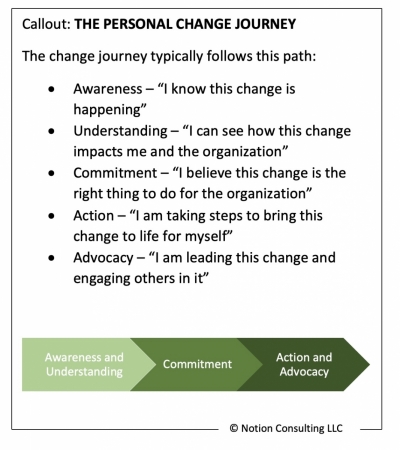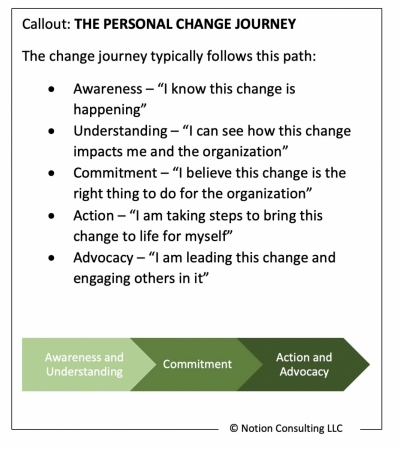Mid-level leaders have two roles in driving change in an organization—first, they need to adapt to the change themselves, then they need to lead that change for others.
Navigating Change
The change journey is highly personal, and dependent on each individual’s change resilience and self-awareness. Yet this journey also follows a typical path. Each person must move from awareness and understanding, through commitment, to action and advocacy. These key stages are critical to building new, long-lasting behaviors, mindsets, and ways of working.
 For middle-level managers, who often are not involved in setting the overall strategy, these shifts from awareness through advocacy can be especially challenging, as they are adjusting to the change themselves at the same time they are charged with winning the hearts and minds of their direct reports.
For middle-level managers, who often are not involved in setting the overall strategy, these shifts from awareness through advocacy can be especially challenging, as they are adjusting to the change themselves at the same time they are charged with winning the hearts and minds of their direct reports.
They must quickly ramp up to the point of commitment, and pivot from action into advocacy in order to move the needle and scale the change for the organization.
Leading Change
So how can employers help their leaders get on board fast, so they can engage employees on the ground?
First, senior leaders must articulate a clear and compelling vision that is aligned to business strategy. Then, they must translate this vision for their people through support and tools. And they must commit to the ongoing communication, reskilling, and education required to bring their people along.
Focusing on people managers first, and giving them time and space to understand their own personal change experience, will allow them to internalize the change more quickly, so they can understand their role as a change leader.
Proven Strategies
To help leaders internalize the change, and practice translating it for their people, consider providing a leading-through-change workshop. This can help them understand the impact change can have on people and organizations and help them explore their role in driving the change. During this dedicated time, give leaders the tools and confidence they need to navigate their change journey and react to others. Help them:
- Lead from the inside out. Help leaders map where they are on the change journey, and identify challenges and roadblocks that may be getting in the way of their success.
- Practice talking about change. Use role-playing exercises to practice the language required for productive conversations about change.
- Make a plan for change. Create an individual action plan to help guide personal and team engagement for the long term.
Lasting change doesn’t happen overnight, but given the right balance of time for reflection and practice, communication and tools, and action planning, middle managers can be the key drivers of translating your new vision into action.
Diana Vienne is senior partner at Notion Consulting and has a wealth of experience in business transformation, talent and organizational development, having built her career in consulting at Deloitte and PwC, then as chief talent officer within Omnicom Group and Havas networks. Vienne is active in her community, providing support to nonprofits and holds a Master of Arts degree from New York University in business education and organizational effectiveness.

